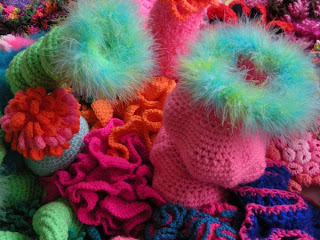 "Crochet Coral and Anemone Garden" with sea slug by Marianne Midelburg.
"Crochet Coral and Anemone Garden" with sea slug by Marianne Midelburg.Photos © The IFF by Alyssa Gorelick.
The Institute For Figuring is crocheting a coral reef: a woolly celebration of the intersection of higher geometry and feminine handicraft, and a testimony to the disappearing wonders of the marine world. Created and curated by IFF directors: Christine Wertheim and Margaret Wertheim.
One of the acknowledged wonders of the natural world, the Great Barrier Reef stretches along the coast of Queensland like a psychadelic serpent, a riotous profusion of color and form unparalleled on our planet. But global warming and pollutants so threaten this fragile monster that scientists now believe the reef will be devastated in coming years. As a homage to the Great One, IFF directors Margaret and Christine Wertheim instigated a project to crochet a woolen reef. The sisters, who grew up in Queensand, have been spearheading the project since 2005, quiety watching as it has morphed into an unexpected and far-reaching wordwide movement.
The Reef begins with the technique of hyperbolic crochet discovered by mathematician Dr. Daina Taimina, which the Institute has taken up and elaborated into a polyphony of organismal crochet procedures, bringing into being in a wide taxonomy of reef-life forms. Loopy "kelps", fringed "anemones", and curlicued "corals" have all been modeled. While the process that brings these models into being is algorithmic, endless permutations of the underlying formulae result in a constantly surprising panoply of shapes. The quality of yarn, style of stitch, and tightness of the crochet all affect the finished forms so that each is as individual as a living organism. As a whole, the Crochet Reef is made up of many different “sub-reefs,” each with its own colors and styling: these include the Bleached Reef, the Beaded Reef, the Branched Anemone Garden, and our largest work, The Ladies’ Silurian Atoll, a ring-shaped installation with close to 1000 individual crochet pieces made by dozens of contributors around the world. In addition to these woolen reefs is the massive Toxic Reef crocheted from yarn and plastic trash - a part of the project that responds to the escalating problem of plastic trash that is innundating our oceans and choking marine life.
 The Bleached Reef (detail) featuring red and white sea slug by Marianne Midelburg,
The Bleached Reef (detail) featuring red and white sea slug by Marianne Midelburg,blue rock-coral by Nancy Lewis, white spires by Evelyn Hardin,
bleached dodecahedron by Lily Chin,
vintage plastic doillies by makers unknown, and miniature beaded corals by Nadia Severns.
Photos © The IFF, by Margaret Wertheim.
Ildiko Szabo's models are among the stars of the UK Reef which was constructed during 2008 and exhibited alongside the IFF's Reefs. For this exhibition Ildiko expanded the repertoire of spiralized forms she's been developing. Seen above are several of these forms fringed with fluorescent down. In this case they are wondrously evocative of anemones with delicate feeding tentacles scanning the water for food. The anemones are surrounded by a cluster of other Ildiko sea creatures - a veritable taxonomy of marine marvels.
The Crochet Reef Project was inspired by the technique of hyperbolic crochet originally developed by Dr Daina Taimina, a mathematician at Cornell. In 1997 Dr Taimina discovered how to make models of the geometry known as "hyperbolic space" using the art of crochet. Until that time many mathematicians believed it was impossible to construct physical models of hyperbolic forms; yet nature had been doing just that for hundreds of millions of years. It turns out that many marine organisms embody hyperbolic geometry in their anatomies - among them kelps, corals, sponges, sea slugs and nudibranchs. Thus the Crochet Reef not only looks like a coral reef, it draws on the same underlying geometry endemic in the oceanic realm.





